Haslingden, Lancashire
Up to 1834
Haslingden had a town workhouse situated on Spring Lane dating from 1749. It could accommodate up to 150 inmates and in 1837 its governor was Henry Rothwell who received a salary of £14 a year. The site was later occupied by the Haslingden brewery.
There was also a workhouse for up to 200 inmates at "Newchurch" — actually at Mitchell Field Nook, Waggoner Tunstead, on a site now occupied by housing. The governor here in 1837 was John Howarth at £19 a year.
The inmates in these early workhouses were employed in handloom weaving.
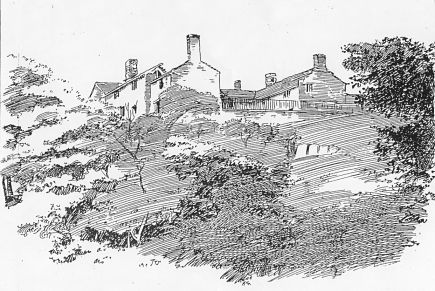
Mitchell Field Nook workhouse.
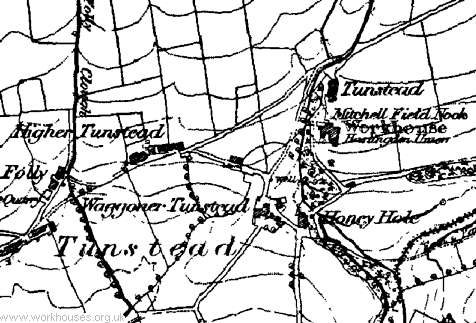
Newchurch workhouse site, 1849.
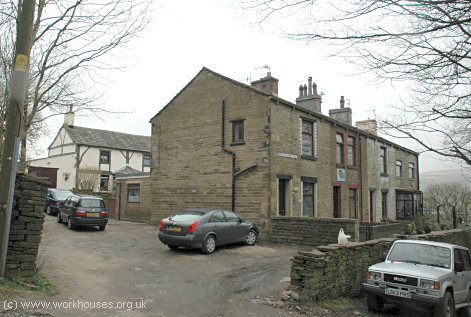
Mitchell Field Nook site, 2006.
After 1834
Haslingden Poor Law Union formally came into being on 17th January 1837. Its operation was overseen by an elected Board of Guardians, 18 in number, representing its 10 constituent parishes and townships as listed below (figures in brackets indicate numbers of Guardians where not one):
Lancashire: New Accrington (3), Old Accrington, Higher Booths (2), Lower Booths; Coupe Lench, New Hall Hey and Hall-Carr; Henheads; Haslingden (4), Musbury, New Church (3), Tottington Higher End.
The population falling within the union at the 1831 census had been 35,304 with parishes and townships ranging in size from Henheads (population 202) to New Church (9,196) and Haslingden itself (7,776).
Like many northern unions, Haslingden was unenthusiastic about operating the New Poor Law. Its first Board of Guardians minutes were not recorded until June 1838, some 18 months after formation of the union. Attendance at meetings was also desultory — in their first year of office between Jun 1838 and June 1839, the average attendance at board meetings of the 18 total Guardians was 4. There were sometimes as few as zero, and the higher attendances often coincided with dates when the meetings were at the Commercial Inn rather than at the Haslingden National School!
Initially, the union rented the existing workhouses at Spring Lane and Newchurch. The administration of these establishments fell considerably short of official requirements: classification and segregation were poor, and inmates wore their own clothes and were allowed to smoke. New arrivals at Haslingden workhouse were first placed in the kitchen before being taken to the wash-house and washed in a tub. From 1851, Haslingden workhouse was used only for male inmates while females were sent to Newchurch. The workhouse matron at Newchurch in 1856 was Mrs Richard Ashworth.
In 1864, the Haslingden Guardians asked the Lancashire and Yorkshire Railway for permission to place collecting boxes at local railway stations, so that which travellers could donate discarded books and periodicals. The Guardians appear to have been surprised when told that one was full - in 1872. One box was still in use at Bacup station in 1919!
A rise in inmate numbers, together with continuing pressure from the Poor Law Board, led to the erection in 1868-9 of a new union workhouse at Higher Pikelaw, midway between Haslingden and Rawtenstall. It was designed by Henry F Lockwood and William Mawson who were the architects of a number of northern workhouses including those at Barnsley, Bradford, Carlisle, Dewsbury, North Bierley and Penistone. The Haslingden site, which was 900 feet above sea-level, is shown on the 1909 map below.
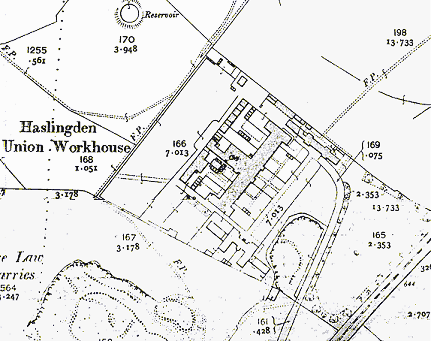
Haslingden workhouse site, 1909.
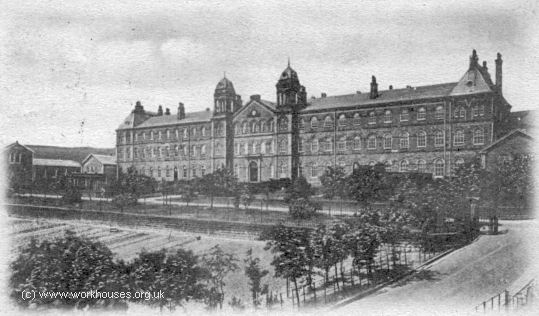
Haslingden workhouse from the east, c.1905.
© Peter Higginbotham.
The workhouse had a T-shaped main block facing to the south east.
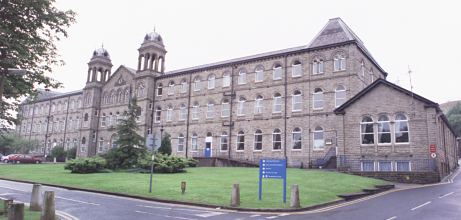
Haslingden main block from the east, 2001.
© Peter Higginbotham.
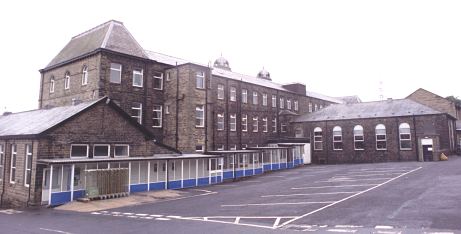
Haslingden dining-hall and rear of main block from the north, 2001.
© Peter Higginbotham.
A block at the north-east of the main building contained the board-room and porter's lodge.
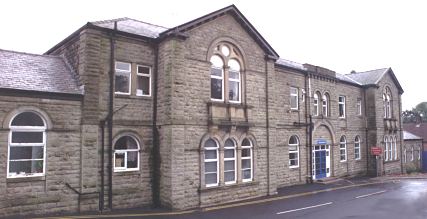
Haslingden board-room and porter's lodge from the west, 2001.
© Peter Higginbotham.
An 88-bed infirmary lay at the south of the site.
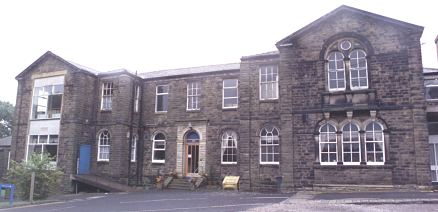
Haslingden original infirmary from the north-east, 2001.
© Peter Higginbotham.
Haslingden, like all workhouses, was the subject of periodic inspection by the Local Government Board. One of these was presented at a Guardian's meeting in October 1891 and reported in the Rossendale Divisional Gazette:
|
GOVERNMENT INSPECTION OF PIKELAW WORKHOUSE The fortnightly meeting of Haslingden Board of Guardians was held on Wednesday, at the Union Workhouse, Pikelaw. Present - Messrs. J. Kenyon (in the chair), J. Duxbury, D. Tunks, H. G. Cunliffe, R. Ormerod, J. Ashworth (Waterfoot), James Taylor, John Taylor, L. Halliwell, R. Ingham, R. Hargreaves, J. Ashworth (Rawtenstall), E. Oddie, J. C. Witham, J. Collinge, N. Worsley, T. Parker; Mr. John Woodcock, solicitor, acting-clerk; and Mr. Bryant, deputy-clerk. Mr. Henley, Local Government Inspector, was also present.
THE CONDITION OF THE WORKHOUSE, AND THE STATE OF PAUPERISM.
Mr. Henley, chief inspector of the Local Government Board, who had visited the workhouse, referred to the satisfactory provision made for the treatment of harmless lunatics in the house, and expressed the opinion that an allowance should be made by the County towards their maintenance. He also touched upon one or two matters in connection with arrangements made in the workhouse for the lunatics. He thought it would be an advantage if some sheds wore put up in the yard, so that the patients could be under cover, when taking exercise. This, he thought, would induce them to get into the open air, and in hot weather and rough weather it would be better to have a covering for their heads. He did not think there was room for an umbrella shed, such as were erected at some watering places, but at a small cost, iron or zinc roofs might be put up against the walls, and he was sure these would be of considerable service. He also referred to the provision for lunatics who were sent there under orders from the justices for periods not exceeding seven days. They might be paupers or non-paupers who were found wandering about, or requiring immediate restraint, who were sent there by the justices under the Act of Parliament. He thought, whoever brought these in, the master should be empowered to get extra help during the time they were in the workhouse, so that their custody would not be thrown on the small staff at the workhouse during the time they were detained there previous to their removal to the asylum. It was generally the custom to send such cases direct to the asylum, but any justice could send such cases to the workhouse for three or seven days, and if they were extremely violent the officers of the workhouse would be almost compelled to lock them up in padded rooms, which would be a most objectionable mode of treatment. They had not strength in the house to watch then both night and day, and the Master or the Guardians ought to get a man or a woman, as the case might be, from outside to look after those people. Either an ex-policeman or someone of that sort would be perfectly suitable. He had received no complaints from the inmates, and all seemed perfectly satisfied with their treatment. The provisions, he found, were much superior to most contract provisions he found in most work houses. (Hear, hear.) | ||||||||||||||||||||||||||||||||||||||||||||||||||||
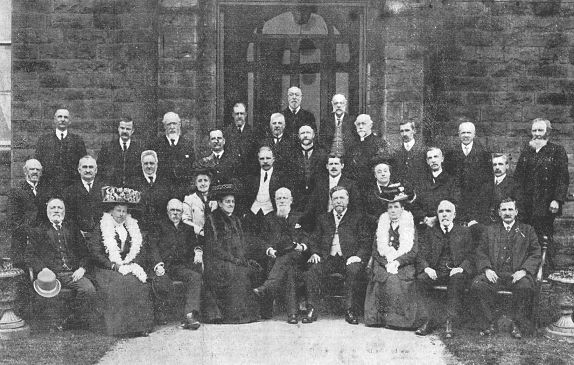
The Haslingden Board of Guardians, 1910.
Another impression of workhouse life is provided by an 1898 feature in the Gazette:
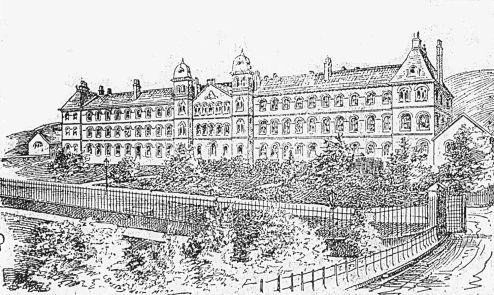
Haslingden workhouse, 1898.
There are 326 inmates within the Workhouse walls, made up of old men and women; young men and women, and boys and girls. One hundred lie on the sick beds of the Infirmary; 72 are imbeciles or idiots, of whom 48 are females; 29 are boys, and 24 are girls, with five infants under two years of age. There are fathers and mothers here; grandfathers and grandmothers, and even great grandfathers and great grandmothers.
|
A major expansion of the site to the north-east of the workhouse began in 1912 with the opening of a new infirmary to the north-east of the workhouse.
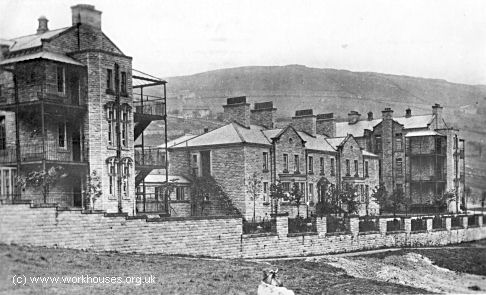
Haslingden new infirmary from the south, c.1929.
© Peter Higginbotham.
The workhouse later became Moorland House Public Assistance Institution, and then Rossendale General Hospital which finally closed in 2010.
Cottage Homes
By the 1920s, the Haslingden Union had established children's cottage homes known as Moorland Cottages on Sandown Road, Haslingden. The homes could accommodate up to 40 children. The property is now in private residential use.
Former Haslingden cottage homes.
Staff
Inmates
Records
Note: many repositories impose a closure period of up to 100 years for records identifying individuals. Before travelling a long distance, always check that the records you want to consult will be available.
- Lancashire Record Office, Bow Lane, Preston, Lancashire, PR1 2RE. Holdings comprise: Guardians' Minute Book (1838-1910); Guardians' Minute Book (Printed, 1907-30); Workhouse Committee Minute Books (1865-70); Letter Books (Poor Law Board - 1838-1902); Letter Books (Local Government Board - 1880-92); Lists of Guardians and Officers (1839-1921); Valuations (1880-82); Miscellaneous Deeds (1703-1829); Sub-Committees' Minute Books (1906-1914); Infirmary Committee Minute Books (1898-1905); Visiting Committee Report Books (1914-19); Boarding-Out Committee Minute Books (1911-20); Year Books (1904-1929); Overseers' Meeting Minutes (1895-1927); Overseers' Financial Records (1856-1927); Miscellaneous (1924-29).
Bibliography
- Rhodes Boyson, The Haslingden Poor Law Union 1848-1930, 1949 (BA Thesis, University of Manchester).
Links
- None.
Acknowledgment
- Thanks to staff at Rawtenstall Library for their help.
Unless otherwise indicated, this page () is copyright Peter Higginbotham. Contents may not be reproduced without permission.


